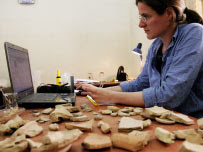
Erbil city has more than 1,000 potential archeological sites. The hills were once villages that were abandoned, destroyed or the inhabitants wiped out by disease. According to Erbil Directorate of Archeology, of the 1,000 archeological sites in Erbil, only one percent has been excavated.
At the end of 2010, archaeologist Nadir Babakir carefully looked at a hill in the Hasarok quarter, a new area on the eastern outskirts of Erbil. After some initial research, Babakir was convinced the hill was a historical site. "Immediately, I informed the Directorate of Archeology and the Ministry of Tourism and municipality about it," he said. "I was very worried because the government had already given the land to the people to build houses on it."
Later, the Directorate of Archeology sent a team to the site and, after some research, the team confirmed it as an archeological site. After that, the Ministry of Municipality told the landowners to stop building houses on and around the land. The ministry compensated the 60 landlords.
The government names the site Nadir, after Babakir. Under Kurdistan law, the government names archaeological sites after the person who discovers them, as a way to honor those who inform the authorities.
The age of the site
The Directorate of Archeology signed an agreement with the University of Athens to excavate the site. A team of archeologists from Athens University has excavated for a month. In a press conference, the head of the Greek team, Dr. Kosta disclosed that the initial research has put the age of the site at around 7,000 years old and it is from the Mesopotamian era.
Dr. Kosta said more than 1,000 archeological artifacts have been found at the site, including sacks, vases and animal paintings, as well as the remains of people, animals and birds. The archaeology excavation site is around 10,000 square meters. "The remains of some of the birds discovered are species that no longer exist," he said. The team will return in October to continue the excavation. Work on the site will continue for five years.
Kurdistan eyes archeological tourism
Kurdistan has at least 1,307 known archaeological sites. Among the most famous is the Erbil Citadel, the oldest continuously inhabited settlement in the world, which has been settled since 6,000 B.C.
Another is the Shanidar Cave, where nine Neanderthal skeletons were found, dating back 60,000 to 80,000 years. The cave is in Bradost Mountain, in Erbil province. It was excavated between 1957 and 1961 by Ralph Solecki and his team from America 's Columbia University and yielded the first adult Neanderthal skeletons in Iraq. One skeleton and casts of the others are at the Smithsonian Institution in Washington, D.C.
Erbil and Suleimaniya both have museums with collections of antiquities, statues and remains from the Region, while Duhok Traditional Museum displays Kurdistan's folklore and heritage.
For more interesting topics related to archaeology, visit archaeology excavations.
1 comment:
Very interesting article, any news from excavations in October? Is there any contact information with the team of Greek archaeologists working there? I am Serbian archaeologist interested in practice in Northern Iraq.
Regards,
Tanja
Post a Comment